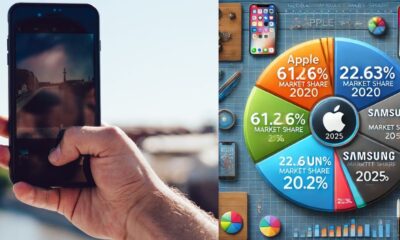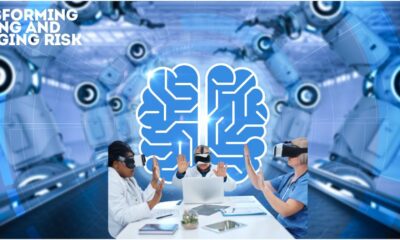Technology
How Technology Is Changing the Future of Education
Amanda Jerelyn is currently working as an Information & Technology tutor at Crowd Writer, an excellent house of best assignment writers UK. As a teacher previously, she was always interested in combining education with technology. Having done extensive research, she now shares her opinions on her blog with a pool of followers.

Technology is a continuously evolving part of our lives. As it develops and paves its way in every aspect of our lives, it is high time we integrate technology in industrial and systematic forums. Education is one of the significant forums that technology has greatly impacted and will continue to do so over the years. From schools to degree colleges and higher education universities, every student at every level can feel the change that is a result of technology.
According to a recent report by Edtechnology, a whopping 96% of teachers say that they believe technology has a positive impact on students and their overall learning. Given such high numbers by the present-day pioneers of education, it is safe to say that technology is now an integral part of the learning sector. It is only a matter of time that the advancements are so perfected and affordable that schools turn to use the only high-tech gear for their classrooms 100%.
Any educator would agree that apart from the argument that technology has negatively impacted the students because of social media and other online activities that take up more time, EdTech has been hugely beneficial to both students and teachers too. One of the major proves that EdTech is a reliable business today is the number of billionaires that have come out of the education sector.
So what new advanced technological advancements show us a promising future in education? Let’s find out.
7 Ways Technology Is Revolutionizing the Education System
Here we have listed seven ways technology is revolutionizing the education system.
1. Education is not limited to the walls of the institutions.
According to the statistics presented by a UN report, 263 million children worldwide are deprived of full-time education. If you consider the global population, the number is still low but still significant. However, technology can counter this situation efficiently, as education now is not limited to the walls of the institutions that provide.
The Internet has made education free for anyone who wants to avail of the immense benefits of having learned something. For children and families who cannot even afford the necessary devices to connect to the Internet can easily be taken under by the many charities and NGOs that help the underprivileged get access to education.
2. Digital Models and simulations
Due to technology, students and teachers both don’t have to rely on printed one-dimensional images present in the textbooks. They can now have a better experience at learning with digital models and three-dimensional virtual simulations in the classroom. The teacher can easily explain the context, and the students will be able to learn better and grasp the concept.
For instance, if there is an architecture design class, then a 3D digital model would better explain the size and measurements o the surface area than a hand-drawn small-scaled image printed in a book. It would even explain how it is supposed to look after the students have completed it without them going through the struggle of assuming.
3. Textbooks are the thing of the past.
As the popularity of smartphones, tablets, and devices like Amazon Kindle has grown, textbooks have been replaced. No need to carry heavily loaded school bags with big textbooks and lockers filled with them. Many schools have their dedicated websites that provide access to the soft copy versions of textbooks to children to use at home.
By doing so, they can use books on the premises but won’t have to carry the burden back home just because they have home a home assignment to complete. Students even gain increased access to more information than just the limited amount present in a textbook.
4. Smart and collaborative classrooms
As per a recent survey report, 53% of the teachers say that technology has made classrooms more vibrant and fun. There is no denying that classes have become more smart and collaborative, given the fact that technology has allowed better tools, devices, and aspects through the Internet that make learning enjoyable. Instead of boring ways of delivering lectures for teachers and for the students to listen, there are collaborative ways where both parties can take part actively.
5. Less dependability on teachers
There is no more a specific role of the teacher where students are just entirely dependant on the individual to help them learn. Teachers are now making an advance arrangement that helps students learn in better ways through collaboration, smart devices, and the Internet, even outside of school. This has created more space for the students as well because now if you are stuck with a report, you can just contact dissertation writers to get your work completed in no time.
6. Enhanced personalized learning
Thanks to emerging technologies being integrated into education, teachers can now plan a lesson to fit each student individually. Given the learning style, pattern, and progress a student makes, such lessons can be designed that help the students learn in a more personalized way and grow at their own pace. It also assists teachers in determining how a class is doing in a particular subject line.
7. Better assessment tools
Technology has also provided a variety of ways and dedicated means to test and score the students. No need to memorize theories and large texts to score better on a test. Students just need to have their concepts clear to answer the questions on a test. The test will then be checked through a computerized non-bias system programmed to give scores and results.
Bottom Line
All in all, many would argue that technology is taking away childhood from kids. There is barely any activity left throughout the day, and children can be seen spending hours in front of a screen. But despite that, technology has paved great ways for education. Parents and teachers can easily control the setback of technology if they time the access children to have to the smart devices. Still, there is no denying that technology is highly beneficial to the future of these children in education.
-

 Press Release4 days ago
Press Release4 days agoNura Labs Files Revolutionary Patent: AI-Powered Wallet Solves the $180 Billion Crypto Staking Complexity Crisis
-

 Press Release2 days ago
Press Release2 days agoGlobal Compound Feeds and Additives Industry Report: Market Expansion and Competitive Insights to 2035
-

 Technology2 days ago
Technology2 days agoWhat to Know Before Switching Cell Phone Network Services in 2025
-

 Press Release3 hours ago
Press Release3 hours agoCrypto WINNAZ Launches First On-Chain Yield Engine for Meme Coins, Enabling 20x–300x Returns


































